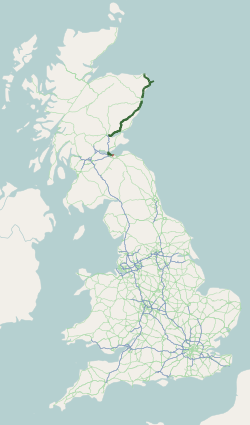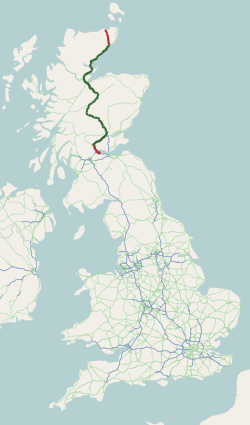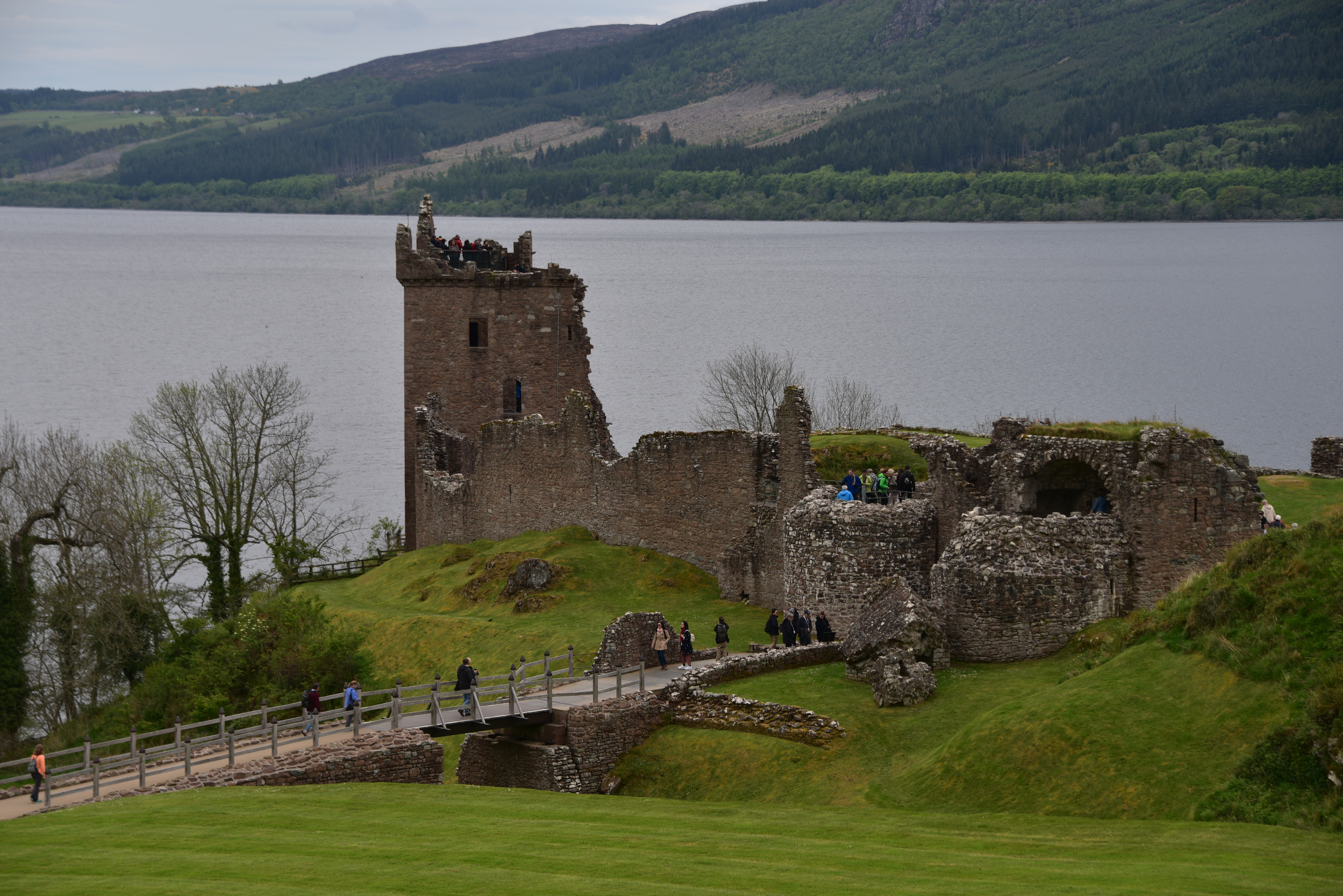|
A82 Road
The A82 is a major road in Scotland that runs from Glasgow to Inverness via Fort William, Highland, Fort William. It is one of the principal north-south routes in Scotland and is mostly a trunk road managed by Transport Scotland, who view it as an important link from the Central Belt to the Scottish Highlands and beyond. The road passes close to numerous landmarks, including Loch Lomond, Rannoch Moor, Glen Coe, the Ballachulish Bridge, Ben Nevis, the Commando Memorial, Loch Ness, and Urquhart Castle. Along with the A9 road (Scotland), A9 and the A90 road, A90 it is one of the three major north–south trunk roads connecting the Central Belt to the North. The route is derived in several places from the Old military roads of Scotland, military roads constructed through the Highlands by George Wade, General George Wade and William Caulfeild (British Army officer), Major William Caulfeild in the 18th century, along with later roads constructed by Thomas Telford in the 19th. The mo ... [...More Info...] [...Related Items...] OR: [Wikipedia] [Google] [Baidu] |
Transport Scotland
Transport Scotland () is the national transport agency of Scotland. It was established by the Transport (Scotland) Act 2005, and began operating on 1 January 2006 as an executive agency of the Scottish Government. Transport Scotland, an executive agency of the Scottish government, manages transport projects, ScotRail, and all motorways and major A-class roads in Scotland. The agency is organised into eight directorates, including Aviation, Maritime, Freight and Canals; Bus, Accessibility & Active Travel; and Rail. Transport Scotland also contributes to the Scottish Government's Climate Change plan. Regional Transport Partnerships (RTPs) help plan and deliver regional transport developments, with each RTP preparing a regional transport strategy and delivery plan. Some RTPs also provide transport services, like the Strathclyde Partnership for Transport which operates the Glasgow Subway and major bus stations. Organisation Transport Scotland is an executive agency of the ... [...More Info...] [...Related Items...] OR: [Wikipedia] [Google] [Baidu] |
Trunk Road
A trunk road is a major highway with a specific legal classification in some jurisdictions, notably the United Kingdom, Sweden and formerly Ireland. Trunk roads are planned and managed at the national-level, distinguishing them from non-trunk roads which are managed by local authorities. Trunk roads are important routes usually connecting two or more cities, ports, airports and other places, which is the recommended route for long-distance and freight traffic. Many trunk roads have segregated lanes in a dual carriageway, or are of motorway standard. The term trunk road, or trunk highway, is sometimes used more generically to refer to other categories of major highway. United Kingdom In the United Kingdom, trunk roads were first defined for Great Britain in the Trunk Roads Act 1936 ( 1 Edw. 8. & 1 Geo. 6. c. 5). Thirty major roads were classed as trunk roads, and the Minister of Transport took direct control of them and the bridges across them. The Trunk Roads Act came int ... [...More Info...] [...Related Items...] OR: [Wikipedia] [Google] [Baidu] |
George Wade
Field Marshal George Wade (1673 – 14 March 1748) was a British Army officer and politician who served in the Nine Years' War, War of the Spanish Succession, Jacobite rising of 1715 and War of the Quadruple Alliance. He went on to be a military commander during the War of the Austrian Succession and Commander-in-Chief of the Forces during the Jacobite rising of 1745. While commanding the British Crown forces in Scotland, Wade was responsible for constructing hundreds of miles of military roads, many of which remain in use. Early career Born the son of Jerome Wade in Killavally, County Westmeath, Ireland, he spent his early years in English Tangier, where his father was a member of the Tangier Garrison. Wade was commissioned into the Earl of Bath's Regiment on 26 December 1690Heathcote, p. 285 and served in Flanders in 1692, fighting at the Battle of Steenkerque in August 1692 during the Nine Years' War and earning a promotion to lieutenant on 10 February 1693. He trans ... [...More Info...] [...Related Items...] OR: [Wikipedia] [Google] [Baidu] |
Old Military Roads Of Scotland
Old or OLD may refer to: Places *Old, Baranya, Hungary *Old, Northamptonshire, England * Old Street station, a railway and tube station in London (station code OLD) *OLD, IATA code for Old Town Municipal Airport and Seaplane Base, Old Town, Maine, United States People * Old (surname) Music * OLD (band), a grindcore/industrial metal group * ''Old'' (Danny Brown album), a 2013 album by Danny Brown * ''Old'' (Starflyer 59 album), a 2003 album by Starflyer 59 * "Old" (song), a 1995 song by Machine Head *"Old", a 1982 song by Dexys Midnight Runners from ''Too-Rye-Ay'' Other uses * ''Old'' (film), a 2021 American thriller film *''Oxford Latin Dictionary'' *Online dating *Over-Locknut Distance (or Dimension), a measurement of a bicycle wheel and frame See also *Old age *List of people known as the Old *''Old LP ''Old LP'' is the fourth studio album by American alternative rock band that dog., released on October 4, 2019, by UME. The album is the band's first since their 20 ... [...More Info...] [...Related Items...] OR: [Wikipedia] [Google] [Baidu] |
A90 Road
The A90 road is a major north-to-south road in eastern Scotland, running from Edinburgh to Fraserburgh, through Dundee and Aberdeen. Along with the A9 road (Scotland), A9 and the A82 (road), A82 it is one of the three major north–south trunk roads connecting the Central Belt to northern destinations. The A90 is not continuous: there is a gap between Dalmeny and Perth, but the M90 motorway, M90 connects those two places. Background The creation and development of the A90 road has to be understood in terms of the development of the economy of the North-East of Scotland, which had resulted in an increase in traffic along the route between Perth and Aberdeen. In recognition of this, in 1979, the British government announced that it was giving priority to the upgrading of the route to dual carriageway standard. It had already been decided that the trunk route between Dundee and Stonehaven, which had previously followed the same route as the railway line between the two towns, w ... [...More Info...] [...Related Items...] OR: [Wikipedia] [Google] [Baidu] |
A9 Road (Scotland)
The A9 is a major road in Scotland running from the Falkirk council area in central Scotland to Scrabster Harbour, Thurso in the far north, via Stirling, Bridge of Allan, Perth and Inverness. At , it is the longest road in Scotland and the fifth-longest A-road in the United Kingdom. Historically it was the main road between Edinburgh and John o' Groats, and has been called ''the spine of Scotland''. It is one of the three major north–south trunk routes linking the Central Belt to the Highlands – the others being the A82 and the A90. The road's origins lie in the military roads building programme of the 18th century, further supplemented by the building of several bridges in later years. The A9 route was formally designated in 1923, and originally ran from Edinburgh to Inverness. The route was soon extended north from Inverness up to John O'Groats. By the 1970s the route was hampered by severe traffic congestion, and an extensive upgrading programme was undertaken on t ... [...More Info...] [...Related Items...] OR: [Wikipedia] [Google] [Baidu] |
Urquhart Castle
Urquhart Castle ( ; ) is a ruined castle that sits beside Loch Ness in the Scottish Highlands, Highlands of Scotland. The castle is on the A82 road, southwest of Inverness and east of Drumnadrochit. The present ruins date from the 13th to the 16th centuries, though built on the site of an early medieval fortification. Founded in the 13th century, Urquhart played a role in the Wars of Scottish Independence in the 14th century. It was subsequently held as a royal castle and was raided on several occasions by the MacDonald Earl of Ross, Earls of Ross. The castle was granted to the Clan Grant in 1509, though conflict with the MacDonalds continued. Despite a series of further raids the castle was strengthened, only to be largely abandoned by the middle of the 17th century. Urquhart was slighting, partially destroyed in 1692 to prevent its use by Jacobitism, Jacobite forces, and subsequently decayed. In the 20th century, it was placed in state care as a scheduled monument and open ... [...More Info...] [...Related Items...] OR: [Wikipedia] [Google] [Baidu] |
Loch Ness
Loch Ness (; ) is a large freshwater loch in the Scottish Highlands. It takes its name from the River Ness, which flows from the northern end. Loch Ness is best known for claimed sightings of the cryptozoology, cryptozoological Loch Ness Monster, also known affectionately as "Nessie" (). Loch Ness lies along the Great Glen Fault, which forms a line of weakness in the rocks which has been excavated by glacial erosion, forming the Great Glen and the basins of Loch Lochy, Loch Oich and Loch Ness. These lochs form part of the Caledonian Canal, linking the Moray Firth and the North Sea to Loch Linnhe on the west coast. The northern end of Loch Ness is around south-west of Inverness, with Fort Augustus located at the other end. The main A82 road between Inverness and Fort William, Scotland, Fort William, roughly follows the western shore, passing through the villages of Drumnadrochit and Invermoriston. Loch Ness is one of the largest in Scotland, and the whole of Great Britain. ... [...More Info...] [...Related Items...] OR: [Wikipedia] [Google] [Baidu] |
Commando Memorial
The ''Commando Memorial'' is a Listed building#Scotland, Category A listed monument in Lochaber, Scotland, dedicated to the men of the original Commandos (United Kingdom), British Commando Forces raised during World War II. Situated around a mile from Spean Bridge, it overlooks the training areas of the Commando Training Depot established in 1942 at Achnacarry Castle. Unveiled in 1952 by the Queen Elizabeth The Queen Mother, Queen Mother, it is one of Scotland's best-known monuments, both as a war memorial and as a tourist attraction offering views of Ben Nevis and Aonach Mòr. History In 1949, the sculptor Scott Sutherland won a competition open to all Scottish sculptors for the commission, ''The Commando Memorial''. Sutherland's design won first prize of £200. The base of the bronze statue is inscribed with the date of 1951. The sculpture was cast by H.H. Martyn & Co. The memorial was officially unveiled by the Queen Mother on 27 September 1952. The monument was first designat ... [...More Info...] [...Related Items...] OR: [Wikipedia] [Google] [Baidu] |
Ben Nevis
Ben Nevis ( ; , ) is the highest mountain in Scotland, the United Kingdom, and the British Isles. Ben Nevis stands at the western end of the Grampian Mountains in the Highland region of Lochaber, close to the town of Fort William. The mountain is a popular destination, attracting an estimated 150,000 visitors a year, around three-quarters of whom use the Mountain Track from Glen Nevis. The mountain has hosted a foot race since 1898. The cliffs of the north face are among the highest in Scotland, providing classic scrambles and rock climbs of all difficulties for climbers and mountaineers. They are also the principal locations in Scotland for ice climbing. The cliffs of the north face can be viewed from the Charles Inglis Clark Memorial Hut, a private alpine hut. The summit is above sea level and is the highest land in any direction for . The summit is a stony plateau (a felsenmeer). It features a number of monuments and the ruins of an observatory which was continu ... [...More Info...] [...Related Items...] OR: [Wikipedia] [Google] [Baidu] |
Glen Coe
Glen Coe ( ) is a glen of glacial origins, that cuts though volcanic rocks in the Scottish Highlands, Highlands of Scotland. It lies in the north of the shires of Scotland, county of Argyll, close to the border with the history of local government in Scotland#Provinces, historic province of Lochaber, within the modern subdivisions of Scotland, council area of Highland (council area), Highland. Glen Coe is regarded as the home of Scottish mountaineering and is popular with hillwalkers and climbers. A 2010 review by NatureScot, Scottish Natural Heritage into the special qualities of Scotland's National scenic area (Scotland), National scenic areas listed the "soaring, dramatic splendour of Glen Coe", and "the suddenness of the transition between high mountain pass and the lightly wooded strath" as being of note. The review also described the journey through the glen on the main A82 road as "one of the classic Highland journeys". The main settlement is the village of Glencoe, Highl ... [...More Info...] [...Related Items...] OR: [Wikipedia] [Google] [Baidu] |
Rannoch Moor
Rannoch Moor (; ) is an expanse of around of boggy moorland to the west of Loch Rannoch in Scotland, from where it extends into westerly Perth and Kinross, northerly Lochaber (in Scottish Highlands, Highland), and the area of Highland Scotland toward its south-west, northern Argyll and Bute. Rannoch Moor is designated a Site of Special Scientific Interest (SSSI) and a Special Area of Conservation. Much of the western part of the moor lies within the Ben Nevis and Glen Coe National Scenic Area, one of 40 such areas in Scotland. It is notable for its wildlife, and is particularly famous as being the sole British location for the Scheuchzeria, Rannoch-rush, named after the moor. It was frequently visited by Horace Donisthorpe, who collected many unusual species of ants on the moor and surrounding hilly ground. Today it is still one of the few remaining habitats for ''Formica exsecta'', the "narrow-headed ant", although recent surveys have failed to produce any sign of ''Formica pr ... [...More Info...] [...Related Items...] OR: [Wikipedia] [Google] [Baidu] |








